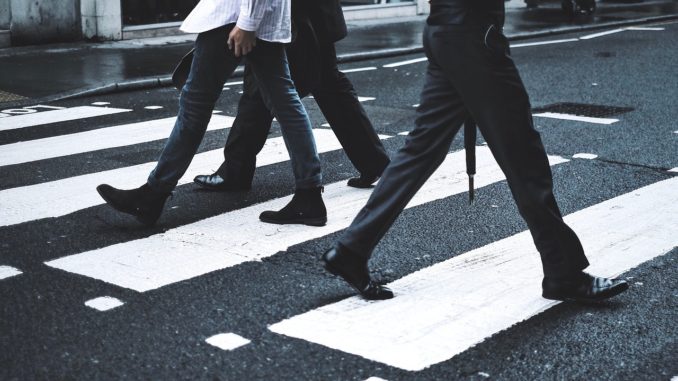
Walking to work is a great way to stay healthy and can save money on commuting costs. In honour of National Walking Month this May Wendy Bumgardner looks at how you can plan ahead to make your walk to work both safer and more comfortable
CREDIT: This is an edited version of an article which appeared on the Verywell Fit website.
Making sure your walk is both healthy and safe requires more than a good pair of walking shoes. Unlike a walk in the woods, you’ll have to carry work back and forth and, unlike a hike you take on a clear day, you’ll encounter varying conditions if choose to walk every day. Walking may simply not be feasible on some days – due to weather or a need to look extra nice for an important meeting. So, if you usually walk to work, you need to be ready for plan B. How can you best prepare for walking to work and benefit from this great form of daily exercise?
1. Plan your route
The best route to walk to work may be different from what you would choose for driving. Try using quieter side streets or paths as much as possible. Look for a route that is away from major roads, both to raise the safety factor and improve the air you breathe. You can use an online walking route planner or app to find, draw and measure a local walking route.
2. Predict your walking time
Don’t be late for work. How long will it take you to walk? For your first walking commute, plan on a pace of 20 minutes per mile, or 12 minutes per km. If you have many streets to cross with traffic lights, you may want to increase that to 25 minutes per mile. Time your first couple of walks so you can better predict your walking pace. If you haven’t had to predict the length of time a walk will take in the past, this may seem a bit daunting; it’s much easier if you first take a moment to know how fast you can walk.
3. Wear the right shoes and socks
You should wear athletic shoes for any walk of over 10 minutes. You may need to change to shoes more appropriate for your work environment when you arrive, either by leaving them at work or carrying them with you. Athletic shoes support your feet correctly for walking any distance, preventing foot pain and problems – and don’t forget that socks matter; socks can wick away sweat and help prevent foot blisters.
4. Wear the right walking clothes
Can you walk to work in your usual work clothes? This will depend on the weather, the length of your walk, and whether you wear casual clothes or suits. Your walking clothing should allow a proper walking stride; trousers or skirts that restrict your leg motion should be avoided. For walks of more than 20 minutes you may want to consider wearing proper walking clothing and changing when you get to work.
5. Protect your head and skin
Hats are a good idea if your walk will last more than 10 minutes. Many of us try to avoid ‘hat hair’ by not wearing one, but you will need to keep your head warm in winter and shielded from the sun in summer. Try a different hairstyle if you think this will be a problem. Wear sunscreen in all weather to prevent wrinkles, aging skin and skin cancer.
6. Carrying your stuff
Your usual briefcase or shoulder bag is likely to be uncomfortable to carry for more than 10 minutes. Switching to a backpack or messenger bag will allow you to carry the load while maintaining good walking posture. This can help prevent a backache from walking with poor body alignment. Avoid carrying anything in your hands, which can lead to repetitive strain for your neck, shoulder, elbow or wrist. Lighten the load – papers and books weigh a lot; aim for a load of five pounds or less (including the weight of the bag) for the best walking comfort. Remember that even carrying a backpack can cause neck and back strain.
7. Be prepared for bad weather
Consider always carrying one of those cheap, folded, plastic rain ponchos just in case of an unplanned downpour. Umbrellas may work in some climates, but some find the poncho to be the most effective answer to wind and rain. Dressing in layers can help you prepare for unexpected heat or cold – remove or add a jacket, microfleece vest or windbreaker.
8. Sweat happens – sprucing up at work
Even in cool weather, you may work up a lather on your walk. Give yourself an extra few minutes after arrival to cool down and dry off. Locate the best bathroom for this purpose. If you find you are sweating on the way to work, switch to wearing a sweat-wicking athletic shirt for the walk. Use a washcloth or moistened paper towels to give your armpits a sponge bath. Change into a fresh shirt; you may want to choose work shirts that are wrinkle-resistant so you can bring them with you.
9. Replenish your body
If your walk will take more than 20 minutes plan for a cup of water every 20 minutes by carrying it with you or locating water fountains. After arrival, have a glass of water. For walks of 30 minutes or more, it is good to have a small, post-walk snack that includes protein and carbohydrates to help your body build muscle and restore energy; a drink that includes non-fat milk or soy milk is a good choice. If you’re going to be walking regularly, become familiar with drinking tips and guidelines for walkers.
10. Plan B
Those used to car commuting may feel uneasy at not having a car to use for errands or emergencies. What public transportation is available between home and work? Learn the bus and rail routes, and have the fare on-hand. Would any of your co-workers give you a lift if needed? Can friends or family be on call to pick you up? Planning this ahead will relieve stress and make you a more confident walking commuter.
11. Be safe
As a final note, there are hazards to walking beyond a sudden storm. From aggressive dogs, to pesky bugs, to dangerous strangers, learn about some of the possible walking hazards you may encounter so that you remain alert and healthy.
Walking to work is a great way to improve your overall fitness level while saving money on commuting and taking the time to plan ahead when it comes to your route, walking clothes, hydration and back-up plans can all reduce the stress of your new pursuit.
Don’t forget to follow us on Twitter, like us on Facebook, or connect with us on LinkedIn!


Be the first to comment